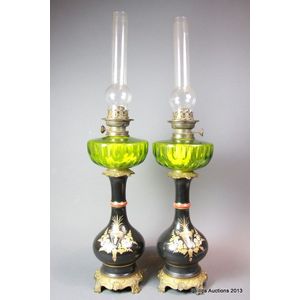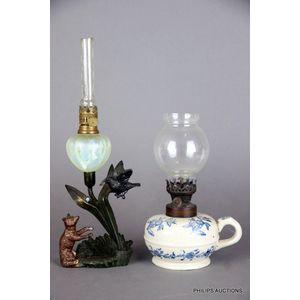Vintage Fuel Lamps with Unique Designs
You must be a subscriber, and be logged in to view price and dealer details.
Subscribe Now to view actual auction price for this item
When you subscribe, you have the option of setting the currency in which to display prices to $Au, $US, $NZ or Stg.
- Oviform /ovoid - The outline loosely resembling the shape of an egg.
- Spelter - Spelter was the name given to an alloy of zinc and brass or copper used in the 19th century for statuary and lighting. It is a brittle bluish-white metal. It was used as a cheap replacement for bronze, but being brittle easily breaks and can't be repaired. When finished it can often be mistaken for bronze, but if discreet a scratch on the base displays shows a greyish colour, the metal is spelter, if a golden colour the metal is most likely bronze.
- Opalescent / Opaline - The descriptions of glass as "opalescent" or "opaline" are often used interchangeably by dealers and auction houses. At the upper end of the scale, opalescent / opaline glass can refer to the opal-like milky blue glass produced by Lalique and Etling. It also refers to the pressed glass mass produced in Britain from the 1840s with a milky white edge as sugar-basins, milk jugs and vases were made in great quantities for the mass market, and were sold at fairs along with Staffordshire figures and wooden dolls. A less common type of opalescent glass was made from two layers of glass blown into a mould.
This item has been included into following indexes:
- kerosene / oil lamps, glass colour - glass, blue 55
- kerosene / oil lamps, material
Visually similar items

A pair of Victorian porcelain and ormolu oil lamps, mid 19th century, with an onion-shaped black porcelain body finely decorated with gilt, red and white floral emblems, the stem supporting the sliced chartreuse glass font, brass mechanism and flue, the wh

French oil lamp, with amber reservoir, 53 cm high

Pair Baccarat crystal Candelabras, each with suspended crystal lustres & etched hurricane shades. Height 57 cm (each) (total)

Early Austrian Ditmar banquet table lamp. Brass base, with chimney. Height 23 cm (base)
